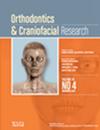Effects of Bioactive NanoAg-ACP Microparticles on the Bond Strength of a Commercial Orthodontic Adhesive and Enamel Resistance to Demineralization
Abstract
Objective
This study was to assess the effects of nanoAg-ACP microparticles as additional fillers on the shear bond strength of Phase II Dual Cure orthodontic adhesive and the enamel demineralisation of teeth using such adhesive.
Materials and Methods
Experimental adhesive was formulated by incorporating 2.5 wt% nanoAg-ACP microparticles into Phase II Dual Cure immediately before use. Brackets were bonded to extracted human premolars using Phase II Dual Cure for one group and experimental adhesive for the second. Samples in each group were randomly assigned to three sub-groups for different post-bonding treatments. Debonding force was measured after post-bonding treatments and used to calculate shear bond strength. DIAGNOdent was used to assess enamel demineralisation for sub-groups treated with acid gels.
Results
The shear bond strength for Phase II Dual Cure and experimental adhesive was 19.06 ± 2.88 and 13.90 ± 2.22 MPa, respectively, after 24-h aging, 15.98 ± 5.44 and 15.31 ± 4.22 MPa, respectively, after 5-month aging, and 14.72 ± 3.15 and 14.46 ± 4.66 MPa, respectively, after 3-week demineralisation following 5-month aging. After being aged for 5 months and demineralised for 3 weeks, samples bonded using Phase II Dual Cure had a higher DIAGNOdent value of 65.00 ± 14.66 compared to 49.77 ± 20.64 for samples bonded using experimental adhesive (p < 0.05).
Conclusions
NanoAg-ACP microparticles could be added into Phase II Dual Cure as fillers to resist demineralisation without impairing the shear bond strength. The results warrant further investigation of nanoAg-ACP microparticles as fillers for orthodontic adhesives using more clinically relevant in vitro models to confirm their potential clinical application in orthodontic treatments.

 求助内容:
求助内容: 应助结果提醒方式:
应助结果提醒方式:


